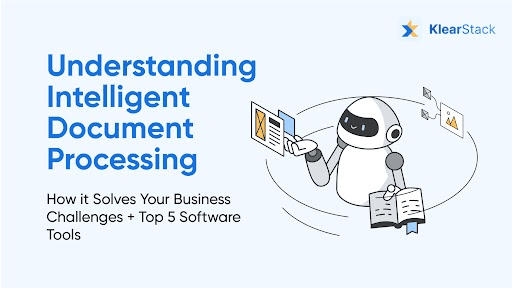Businesses often juggle with data overload. Companies looking to understand what is intelligent document processing often start with a common challenge: managing overwhelming paperwork. Invoices, forms, and client documents pile up, while staff members scramble to keep processes smooth. The implementation of intelligent document processing has become crucial for modern businesses facing these challenges. This manual approach can lead to small but frequent mistakes, repeated tasks, and missed opportunities.
You might be thinking about a few pain points like:
- Are your teams slowed down by retyping the same data into multiple systems?
- Do manual checks create gaps in compliance or record-keeping?
- Could better document management free up staff for higher-level work?
Many organizations are discovering that advanced intelligent document processing solutions can address these challenges effectively. By extracting and organizing data automatically, modern intelligent document processing turns a cluttered stack of documents into a streamlined workflow. The next sections explain how it works, why it’s useful, and what software options can help you get started.
What is Intelligent Document Processing (IDP)?
When exploring what is intelligent document processing, you’ll find it combines traditional OCR with machine learning to read, understand, and route documents automatically. The best intelligent document processing software available today goes beyond just turning images into text – it interprets the meaning behind the words or numbers, helping businesses skip tedious data-entry routines.
Some key aspects that make intelligent document processing solutions effective include:
- Beyond Basic OCR: Modern intelligent document processing classifies forms, extracts data fields, and pinpoints context (such as amounts or dates).
- Continuous Learning: As machine learning models see more data, they adapt to new layouts or unusual cases.
- Automated Decisions: Understanding what is intelligent document processing means recognizing its ability to trigger workflows or send alerts if specific conditions are met.
Once the system captures the data, it usually feeds a database or business application. This shift removes the need to double-check each form. Teams implementing intelligent document processing use cases can then spend more time on tasks that demand human insight, like reaching out to clients or refining product strategies.
Key Benefits of Implementing Intelligent Document Processing
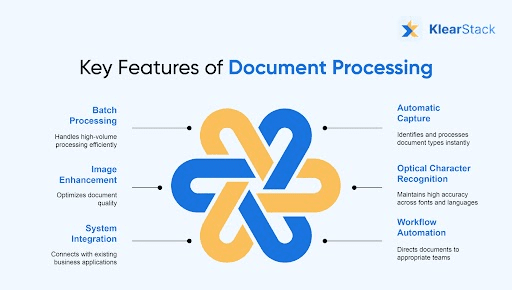
Organizations exploring intelligent document processing use cases often discover its power in resolving issues that stem from manual document handling. Advanced intelligent document processing transforms slow turnaround, duplicates, and inconsistent record-keeping into streamlined workflows. By offloading these tasks to a system that never gets tired, businesses implementing intelligent document processing solutions see a noticeable jump in productivity.
Core Advantages
The best intelligent document processing software delivers multiple benefits:
- Time Savings: Automated data capture trims hours of manual input, letting staff move on to tasks that matter.
- Fewer Errors: A well-trained machine learning model is less likely to slip up on repetitive fields or complex tables.
- Better Compliance: For those wondering what is intelligent document processing’s impact on compliance, digitized records are easier to secure, audit, and reference when needed.
- Scalability: As your document volume grows, intelligent document processing can keep pace without requiring additional data-entry staff.
Ultimately, these benefits shape a more efficient operation. Businesses gain the flexibility to handle seasonal spikes in paperwork or shift personnel to roles that encourage growth, rather than pure data administration.
Top 5 Intelligent Document Processing Software
Let’s begin with a small comparison table for Top 5 Intelligent Document Processings Software.
| Parameter | KlearStack | ABBYY Flexicapture | Adobe Acrobat Pro DC | ReadIris | Tungsten Automation(formerly Kofax) |
| Accuracy | 99% | 94% | 97% | 96% | 98% |
| Pricing | Starts from 10,000 to 100,000 Pages/Year. | Starts from $99/year | Starts from $12.99/mo | $844 | Starts from $3,500 for 100,000 pages per year |
| Integration | RPA, Quickbooks, API | Alteryx, Bizagi, Pegasustems, Blue Prism, UiPath, SAP, m-Files, SharePoint, Laserfiche | Salesforce, Zoho CRM, and Microsoft Dynamics 365. | Arabic/Hebrew Scripts, Asian CJK OCR, Desktop OCR, Excel OCR, Farsi/Persian/Iranian, IRIS | Third-party AI solutions and open source ML tools such as Python, Webservices, .NET, SOAP and REST |
Now let’s examine what is intelligent document processing software in depth. This will give you a more concise understanding of their features and working.
1. KlearStack
Key Features of KlearStack:
- Supports All Document Types: Handles a wide range of formats, from invoices to credit notes, ensuring versatility across departments.
- Seamless Integrations: Works effortlessly with RAP, QuickBooks, and APIs, fitting smoothly into existing workflows.
- Template-free data extraction: Extract data from any document, any format, and adapt business intelligence of highest level.
- Self-Adaptive Models: Processes even entirely new document formats with remarkable accuracy, outperforming traditional solutions.
- Eliminates Manual Data Entry: Automates repetitive tasks, saving time and lowering labor costs.
- End-to-End Encryption: Maintains data security and compliance with industry standards.
In addition to its robust document processing capabilities, KlearStack offers features like automated approvals, compliance monitoring, and real-time analytics. These added functionalities not only streamline operations but also provide actionable insights into business performance, helping organizations make informed decisions.
ABBYY FlexiCaptu
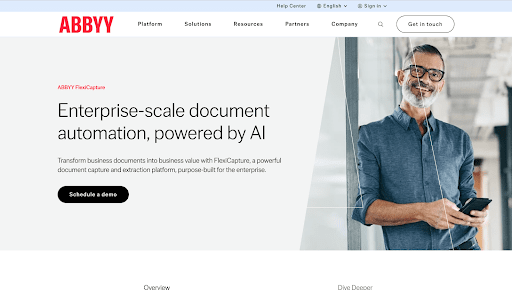
Key features of ABBYY FlexiCapture:
- Intelligent Data Extraction: Uses AI-powered algorithms to capture and extract data from structured, semi-structured, and unstructured documents.
- Advanced Classification: Automatically identifies document types and routes them for appropriate processing based on content.
- Integration with Workflows: Easily integrates with enterprise systems like ERPs, CRMs, and RPA platforms to streamline document handling.
3. Adobe Acrobat Pro DC
Key features of Adobe Acrobat Pro DC:
- Text Recognition with OCR: Converts scanned documents and images into editable and searchable PDFs with high accuracy.
- Document Editing and Annotation: Provides robust tools to edit, annotate, and collaborate on documents in real-time.
- Cloud Integration: Syncs with cloud storage solutions for secure access, sharing, and collaboration from anywhere.
4. ReadIris
Key features of ReadIris:
- Document Conversion: Transforms paper documents, images, and PDFs into editable Word, Excel, or text formats.
- Multi-Language Support: Recognizes and processes documents in over 130 languages, ideal for global operations.
- Batch Processing: Handles bulk document conversion and classification, saving time in high-volume scenarios.
5. Tungsten Automation
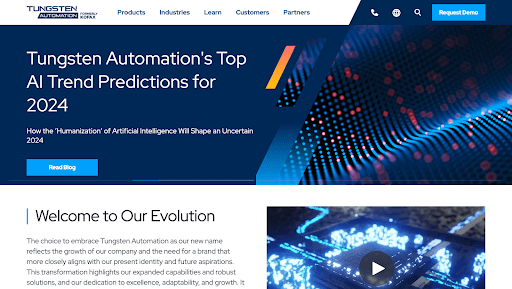
Key features of Tungsten Automation:
- Invoice Processing: Automates end-to-end invoice capture, validation, and approval, reducing errors and delays.
- Compliance Monitoring: Ensures document handling aligns with tax and regulatory requirements globally.
- Analytics and Reporting: Provides actionable insights into document workflows to improve efficiency and decision-making.
Essential Components of an IDP Solution
Understanding what is intelligent document processing requires knowledge of its core technologies. The implementation of intelligent document processing solutions depends on multiple advanced technologies, each playing a distinct role in automating and enhancing document workflows.
Optical Character Recognition (OCR)
OCR technology forms the backbone of intelligent document processing, focusing on recognizing and converting image-based or handwritten text into machine-readable formats. It scans various document types and turns them into editable and searchable data.
Key Functions of OCR:
- Transforms scanned invoices into text for easy copying, editing, or sharing
- Converts physical documents into digital files, eliminating manual data entry.
OCR’s ability to digitize and process paper-based records makes it a foundational component of IDP, ensuring faster and more accurate workflows.
Natural Language Processing (NLP)
NLP enhances IDP systems by enabling them to understand and interpret human language. This capability is vital for analyzing unstructured data, such as email text, customer queries, or support tickets, and extracting relevant details.
Key Functions of NLP:
- Identifies critical details like dates, names, or sentiments within unstructured text.
- Understands the context of documents, ensuring only relevant information is processed.
For example, NLP helps IDP systems analyze an email and extract actionable data like deadlines or sender information, making document handling smarter and more efficient.
Machine Learning (ML) and Artificial Intelligence (AI)
Companies implementing intelligent document processing use cases benefit from ML and AI technologies that enable systems to continuously learn and adapt to new document types and patterns, improving accuracy and reducing manual intervention over time.
Key Functions of ML and AI:
- Enhance data extraction accuracy by recognizing patterns and adapting to new formats.
- Continuously improve processing efficiency through self-learning mechanisms.
Like humans refining their skills through practice, ML and AI make IDP systems more effective at identifying, interpreting, and processing documents with each interaction.
Data Extraction and Classification Algorithms
These algorithms function as “information detectives,” identifying specific data points and organizing documents into logical categories for seamless processing. Modern intelligent document processing solutions rely heavily on these components for accurate data capture.
Key Functions of Data Extraction and Classification:
- Pinpoint crucial details like invoice due dates or customer names with precision.
- Sort documents into predefined categories, streamlining organization and workflows.
By simplifying and structuring the flow of data, these algorithms add another layer of efficiency to IDP solutions.
Robotic Process Automation (RPA)
RPA acts as a virtual assistant, automating repetitive tasks in document processing workflows. The best intelligent document processing software combines RPA with other technologies to reduce the need for human intervention.
Key Functions of RPA:
- Automates tasks like document sorting, routing, and approvals.
- Improves operational efficiency by reducing manual efforts and optimizing workflows.
When combined with other IDP components, RPA ensures that even the most routine tasks are handled with precision and speed, enhancing overall productivity.
These technologies work in harmony to make IDP systems highly effective for processing, analyzing, and managing a wide variety of documents. Together, they save time, reduce errors, and make complex workflows simpler and more reliable.
Use Cases for Intelligent Document Processing Across Industries
The versatility of intelligent document processing use cases spans numerous industries. Leading intelligent document processing solutions help businesses reduce errors, save time, and improve productivity across various sectors:
1. Accounting
The accounting sector generates an overwhelming amount of paperwork, including invoices, bills, receipts, and contracts. Managing these documents manually can lead to inefficiencies, errors, and higher processing costs.
Key Benefits of IDP in Accounting:
- Faster processing of invoices and receipts.
- Reduced risk of human errors.
- Lower processing costs and better compliance.
With IDP, late payments become less frequent, and businesses can focus on improving cash flow and revenue generation instead of struggling with document backlogs.
2. Foreign Currency Reconciliations
Reconciliation processes, especially in foreign currency transactions, are often repetitive and time-consuming. IDP makes these processes faster and more accurate, allowing organizations to focus on exceptions that truly require human oversight.
Key Benefits of IDP in Reconciliation:
- Automated transaction matching for faster workflows.
- Improved focus on open entries and exceptions.
- Enhanced accuracy, minimizing manual interventions.
With IDP, reconciliation teams gain more time to handle high-value activities, ensuring smoother operations and better resource allocation.
3. Legal Services
Legal firms handle extensive documentation daily, ranging from compliance files to property filings and contracts. Manual handling of these documents can lead to errors and delays.
Key Benefits of IDP in Legal Services:
- Automated processing of contracts, compliance files, and property documents.
- Improved data security and error reduction.
- Enhanced productivity for legal associates.
By automating documentation workflows, IDP ensures better quality control and allows legal professionals to focus on case priorities instead of tedious paperwork.
4. Healthcare and Medical Records
In healthcare, maintaining patient records is critical, especially in emergencies. Manually retrieving information can waste precious time and lead to delays in patient care.
Key Benefits of IDP in Healthcare:
- Automated extraction of patient data from medical histories.
- Quick access to relevant information during emergencies.
- Streamlined documentation for better record management.
IDP simplifies the process of extracting and managing patient information, ensuring doctors and medical staff can access accurate data when it matters most.
5. Employee Reimbursement Claims and Fraud Detection
Fraudulent claims and duplicate expenses can significantly impact a company’s bottom line. Manual reviews often miss these inconsistencies, leading to unnecessary cash outflows.
Key Benefits of IDP in Fraud Detection:
- Identifies inconsistencies in expense claims.
- Reduces fraudulent disbursements through automated audits.
- Speeds up reimbursement processing while cutting out rejected claims.
By automating expense claim validation, IDP saves organizations both time and money, ensuring only legitimate expenses are approved.
6. Trade Finance
Trade finance processes are heavily paper-based, leading to delays, high costs, and error-prone workflows. With IDP, banks and financial institutions can automate these labor-intensive processes.
Key Benefits of IDP in Trade Finance:
- Faster document verification for reduced turnaround times.
- Lower operational risks associated with manual checks.
- Cost savings through optimized handling and storage.
IDP not only enhances efficiency but also helps organizations maintain compliance in trade finance operations, ensuring smooth and secure transactions.
7. Supply Chain Management
In supply chain operations, the complexity of semi-structured invoices and a lack of automation often result in delays and higher costs. IDP addresses these challenges by simplifying document workflows.
Key Benefits of IDP in Supply Chain:
- Matches and organizes data across systems for seamless integration.
- Automates processes like purchase-to-pay and order-to-cash.
- Reduces tasks that add little value, freeing up resources for strategic operations.
By streamlining end-to-end processes, IDP helps supply chain organizations save time, reduce costs, and focus on achieving operational excellence.
IDP’s versatility makes it a valuable asset for any industry dealing with unstructured data. Its ability to automate repetitive tasks, enhance accuracy, and improve workflows is transforming how businesses handle documents.
Why Should You Choose KlearStack?
When evaluating intelligent document processing solutions, KlearStack stands out as a leading solution designed to revolutionize how businesses handle accounts payable and document workflows. Organizations implementing intelligent document processing find that KlearStack’s advanced features and seamless integrations make it one of the most reliable options for modern enterprises.
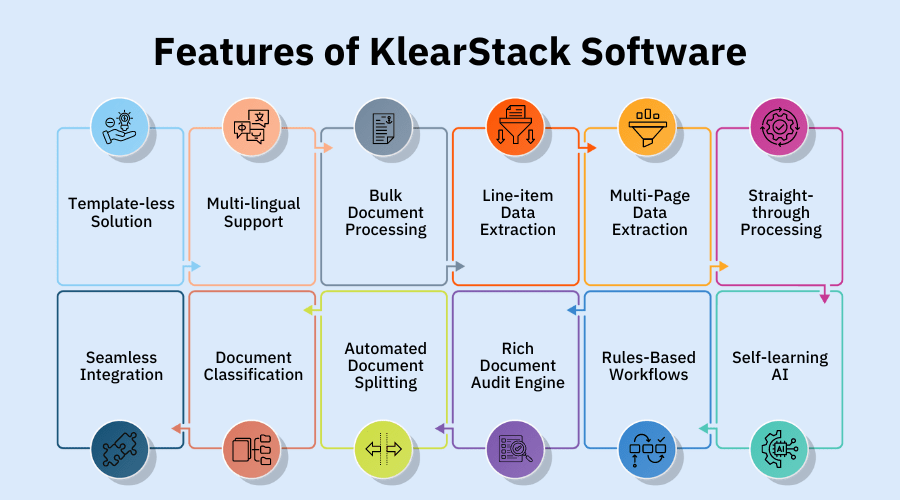
Powered by artificial intelligence (AI) and machine learning (ML), KlearStack redefines document processing by delivering exceptional accuracy and efficiency. With data extraction precision of up to 99%, KlearStack eliminates the need for manual intervention. Businesses can seamlessly process invoices, credit notes, and other financial documents without errors, saving both time and effort.
Key Features of KlearStack:
- Unmatched Accuracy: Achieves up to 99% precision in data extraction, ensuring error-free document processing.
- Automation-Driven Efficiency: Removes repetitive manual tasks, allowing teams to focus on high-value work.
- Scalable for Business Growth: Adapts to increasing document volumes and complex workflows.
Choosing KlearStack not only saves time — it also enables your organization to achieve operational excellence. By streamlining document workflows and improving productivity, KlearStack positions itself as a trusted partner in transforming your processes with unparalleled ease and efficiency.
Save valuable time and resources — Book a Demo today and experience the difference firsthand!
Conclusion
Intelligent Document Processing (IDP) is more than just an automation tool — it’s a transformative solution that addresses the challenges of handling unstructured data. By combining technologies like OCR, NLP, and AI, IDP helps businesses eliminate inefficiencies, reduce errors, and enhance productivity across industries. When examining what is intelligent document processing – you must have a clear understanding.
The implementation of intelligent document processing use cases demonstrates its power across industries. Understanding intelligent document processing solutions and their impact shows how organizations can focus on strategic goals rather than tedious manual processes. For businesses evaluating the best intelligent document processing software, the key is finding a solution that adapts to evolving document formats and business needs..
If your organization struggles with repetitive document workflows, IDP offers a practical way forward. By adopting a solution tailored to your requirements, you can unlock efficiency, improve accuracy, and make data-driven decisions faster. The future of document management is here — don’t wait to transform your operations.

